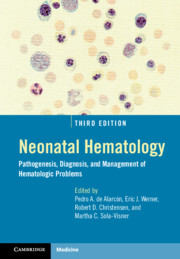Book contents
- Neonatal Hematology
- Neonatal Hematology
- Copyright page
- Contents
- Foreword
- Preface
- Contributors
- Section I Developmental Hematology
- Section II Bone Marrow Failure and Immune Disorders
- Section III Erythrocyte Disorders
- Section IV Platelet Disorders
- Chapter 12 Approach to the Thrombocytopenic Neonate
- Chapter 13 Acquired Thrombocytopenias
- Chapter 14 Fetal and Neonatal Alloimmune Thrombocytopenias
- Chapter 15 Congenital Thrombocytopenias and Thrombocytopathies
- Section V Leucocyte Disorders
- Section VI Hemostatic Disorders
- Section VII Neonatal Transfusion Medicine
- Section VIII Neonatal Oncology
- Section IX Miscellaneous
- Index
- Plate Section (PDF Only)
- References
Chapter 15 - Congenital Thrombocytopenias and Thrombocytopathies
from Section IV - Platelet Disorders
Published online by Cambridge University Press: 30 January 2021
- Neonatal Hematology
- Neonatal Hematology
- Copyright page
- Contents
- Foreword
- Preface
- Contributors
- Section I Developmental Hematology
- Section II Bone Marrow Failure and Immune Disorders
- Section III Erythrocyte Disorders
- Section IV Platelet Disorders
- Chapter 12 Approach to the Thrombocytopenic Neonate
- Chapter 13 Acquired Thrombocytopenias
- Chapter 14 Fetal and Neonatal Alloimmune Thrombocytopenias
- Chapter 15 Congenital Thrombocytopenias and Thrombocytopathies
- Section V Leucocyte Disorders
- Section VI Hemostatic Disorders
- Section VII Neonatal Transfusion Medicine
- Section VIII Neonatal Oncology
- Section IX Miscellaneous
- Index
- Plate Section (PDF Only)
- References
Summary
Thrombocytopenia occurs in less than 1% of all newborns. However, thrombocytopenia is a common finding in the intensive-care nursery where it is present in 25–35% of admitted infants [1, 2]. See Chapters 12 and 13 for a discussion of the approach to thrombocytopenia as well as acquired causes of thrombocytopenia in newborns. This chapter will focus primarily on the diagnosis and initial management of inherited thrombocytopenia disorders that present in infancy.
- Type
- Chapter
- Information
- Neonatal HematologyPathogenesis, Diagnosis, and Management of Hematologic Problems, pp. 243 - 260Publisher: Cambridge University PressPrint publication year: 2021



